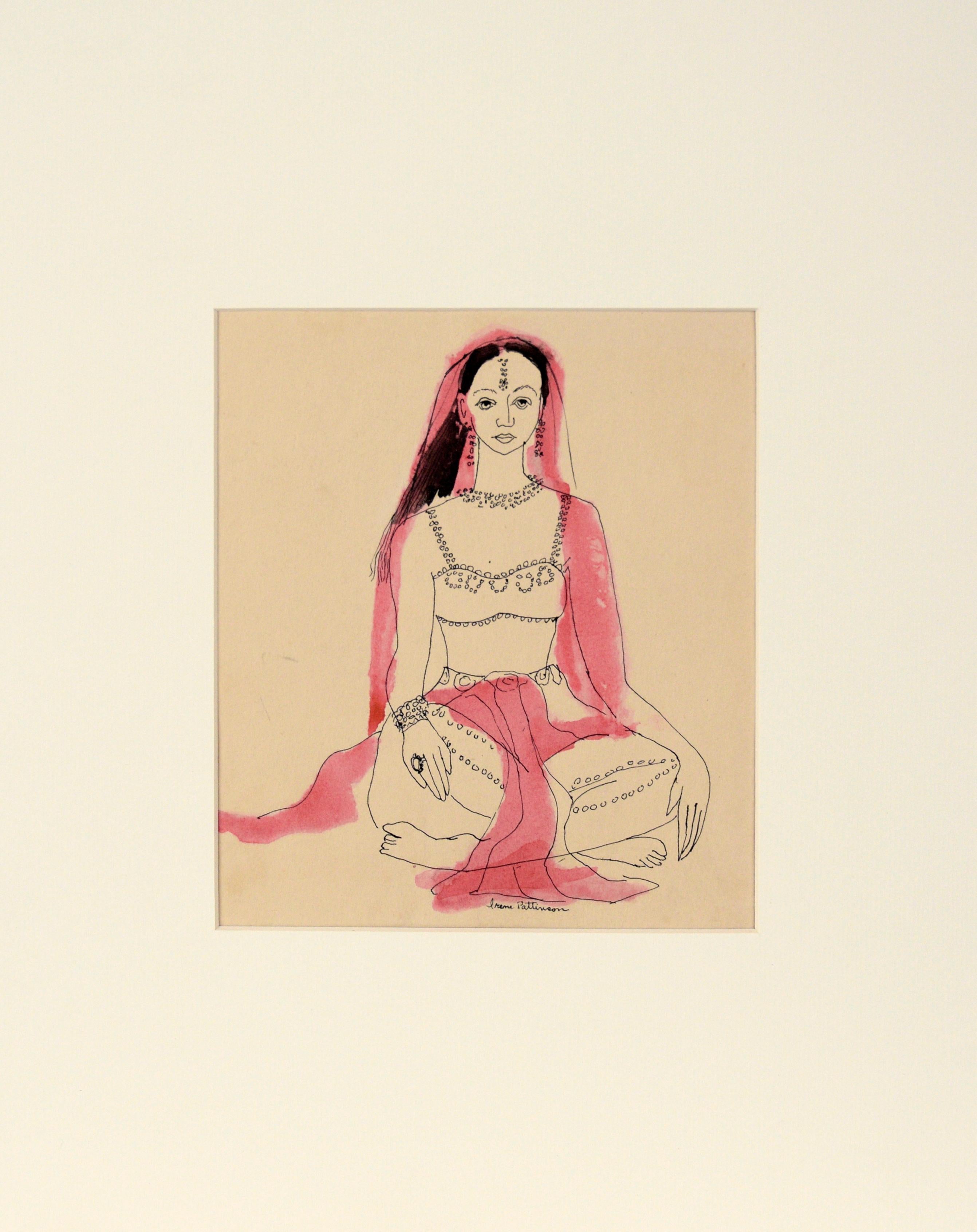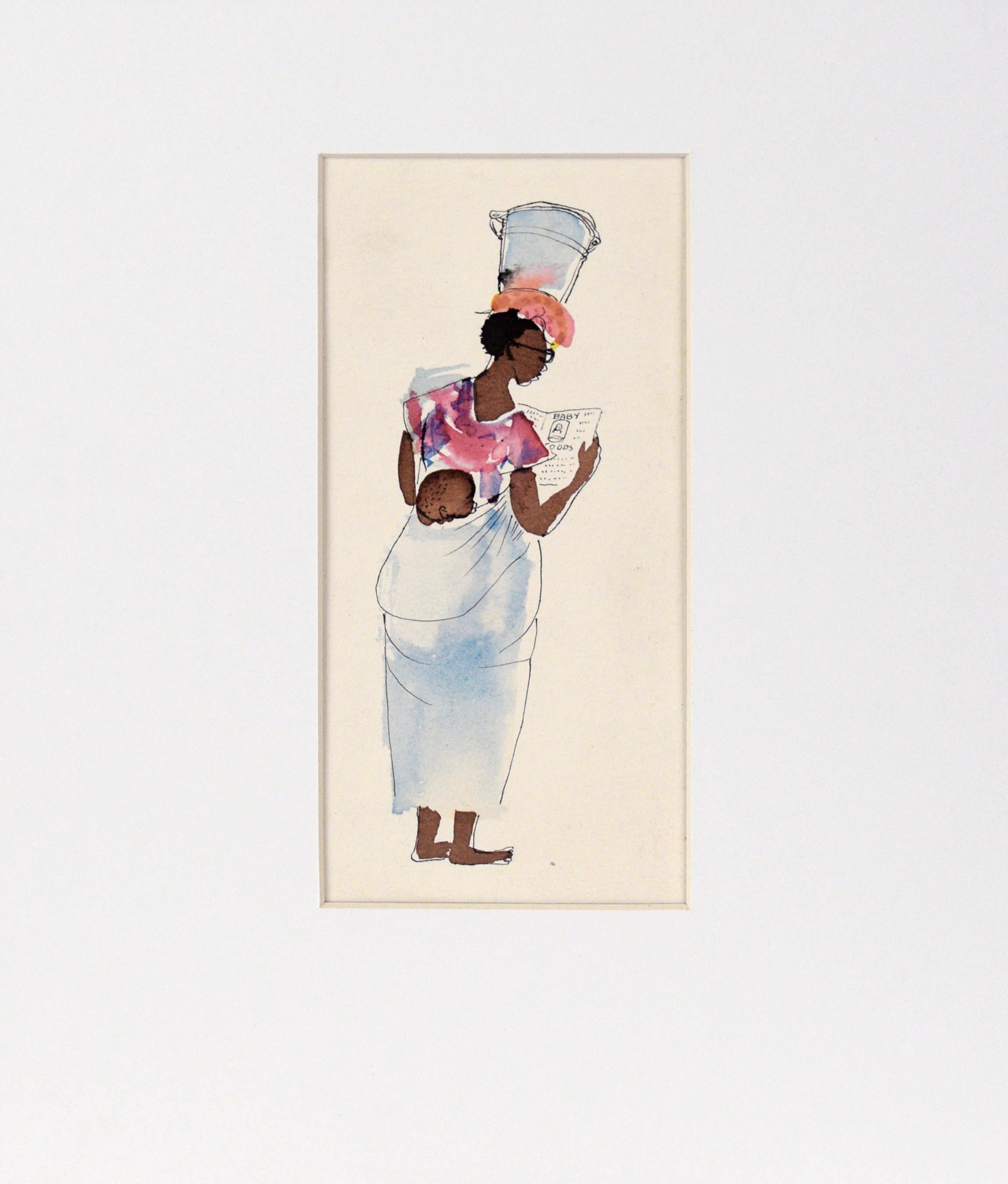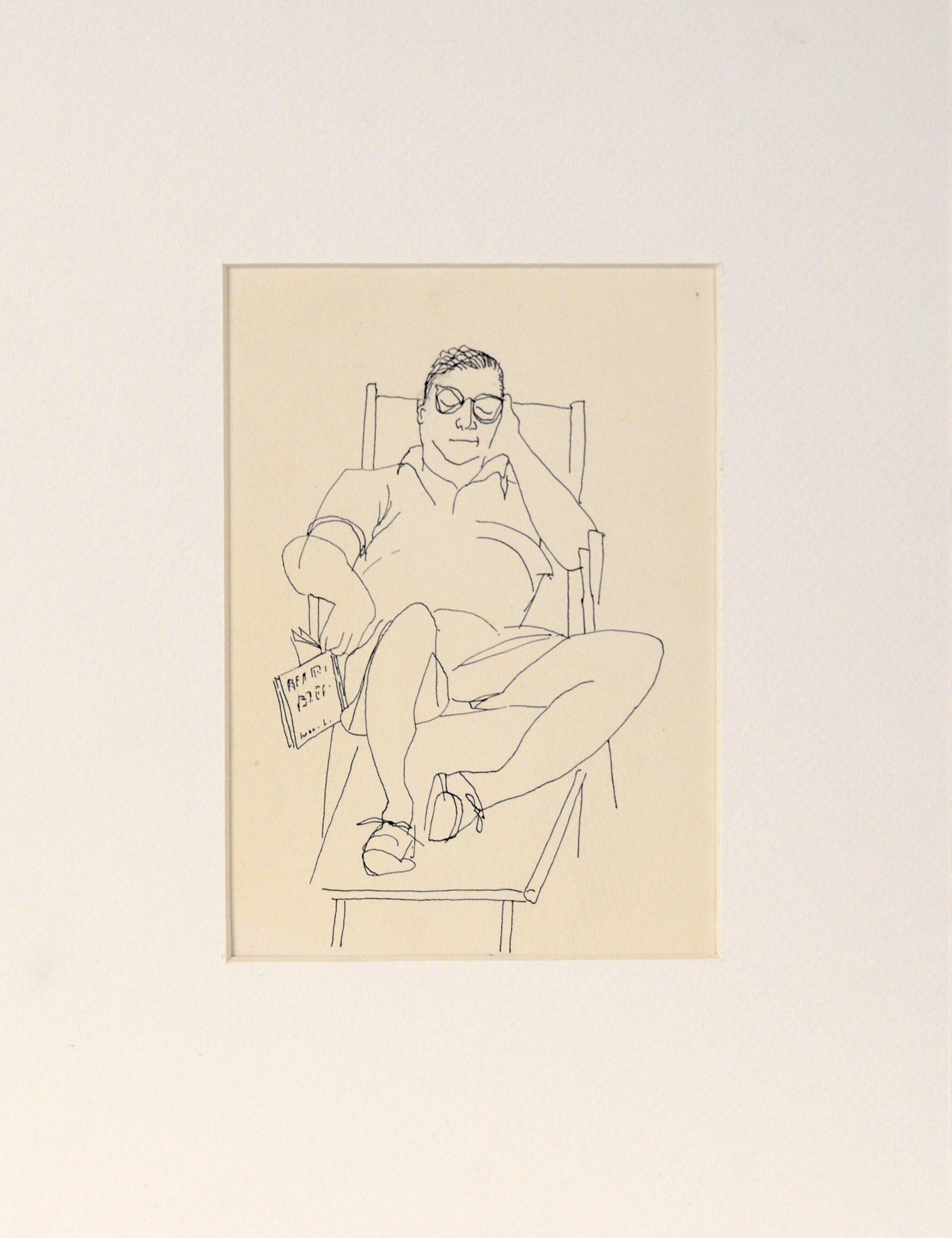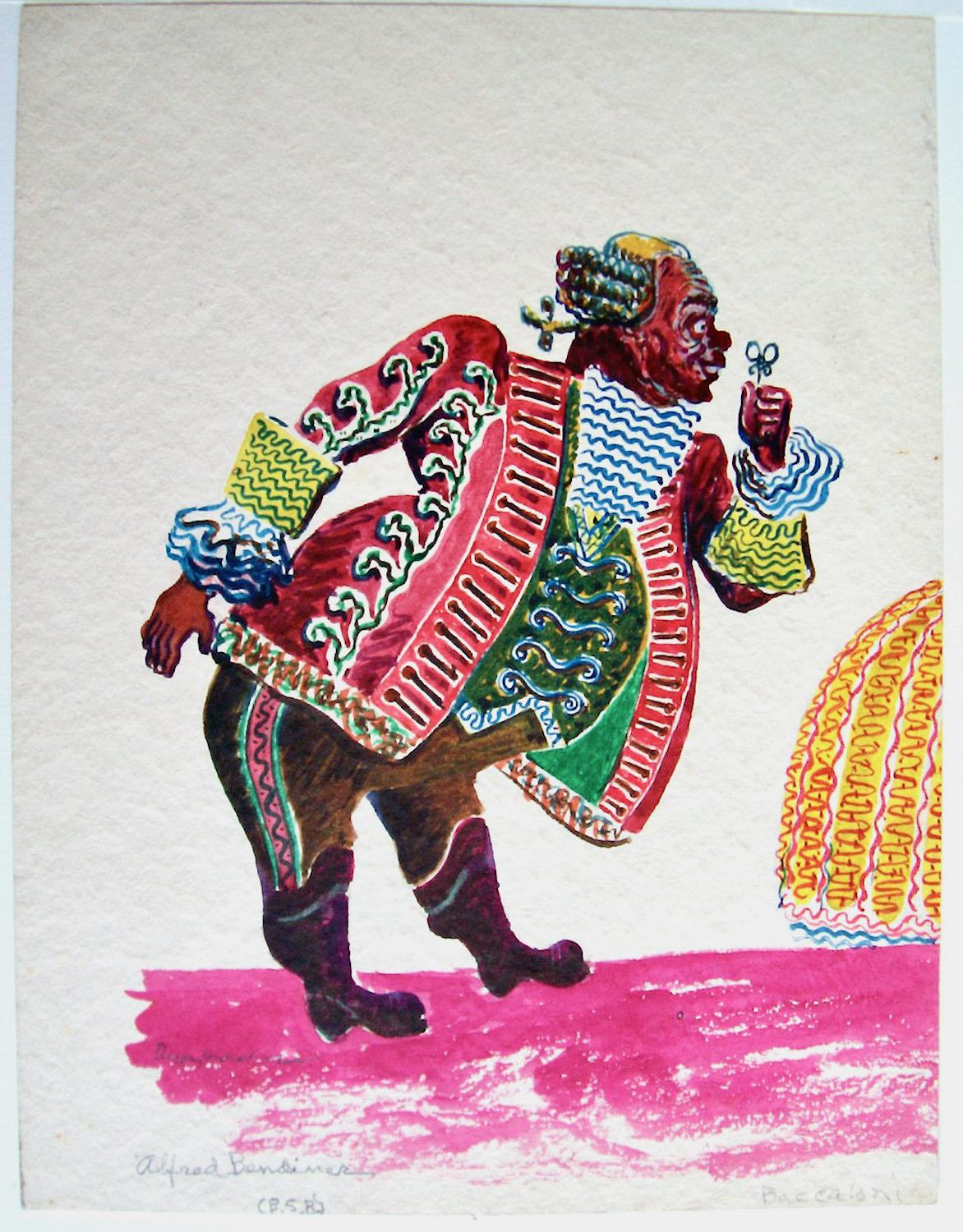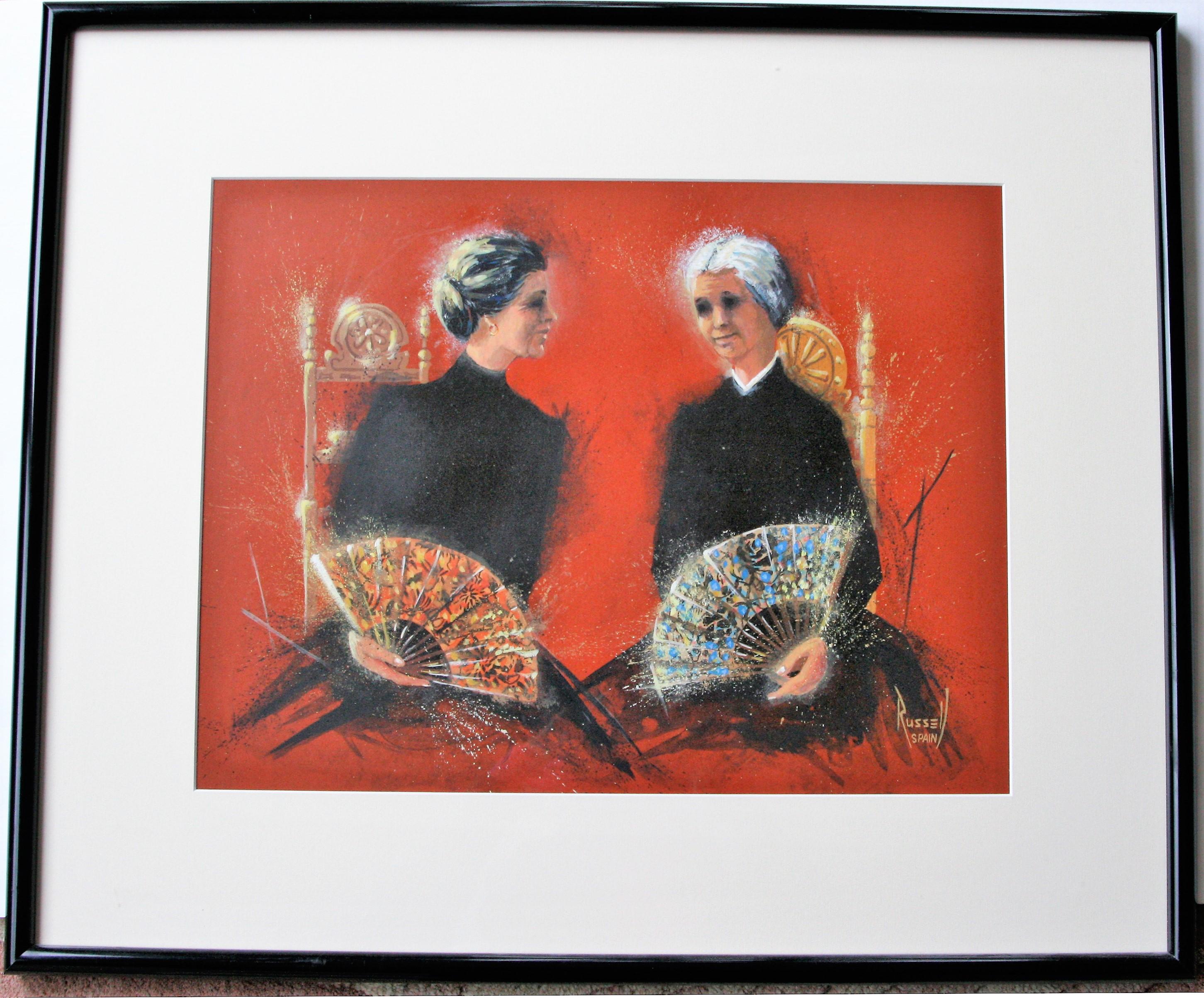Items Similar to Alfred Bendiner, (Baseball Hitter and Pitcher -- The Philadelphia Phillies?)
Want more images or videos?
Request additional images or videos from the seller
1 of 5
Alfred BendinerAlfred Bendiner, (Baseball Hitter and Pitcher -- The Philadelphia Phillies?)1959
1959
About the Item
Of course it's possible that these baseball players aren't from a Philadelphia team, but I doubt it. There was so much drama and intrigue with both the Philadelphia Phillies and the Philadelphia Athletics that Bendiner could hardly have kept away!
The Athletics left in 1955 so probably these are Phillies players, whether warming up or in a game is hard to say. We made the pair.
From 1957 to 1961 the number 43 was assigned to the Philadelphia Phillies player (and winning pitcher), Turk Farrell (1934-1977). The story of the two Philadelphia baseball teams, the Phillies and the Philadelphia Athletics, is filled with some highs and many lows. The word "futility' shows up from time to time.
The 7 x 6 inch dimensions refer to the size of a single sheet. For reference they are shown here, together, in a 16 x 20 inch mat. They are individually authenticated by the artist's wife, Betty Bendiner, in pencil.
- Creator:Alfred Bendiner (1899 - 1964, American)
- Creation Year:1959
- Dimensions:Height: 7 in (17.78 cm)Width: 6 in (15.24 cm)
- Medium:
- Movement & Style:
- Period:
- Condition:Both sheets of this pair are in excellent condition. There are a few marks on the reverse.
- Gallery Location:New York, NY
- Reference Number:1stDibs: LU1410212621442
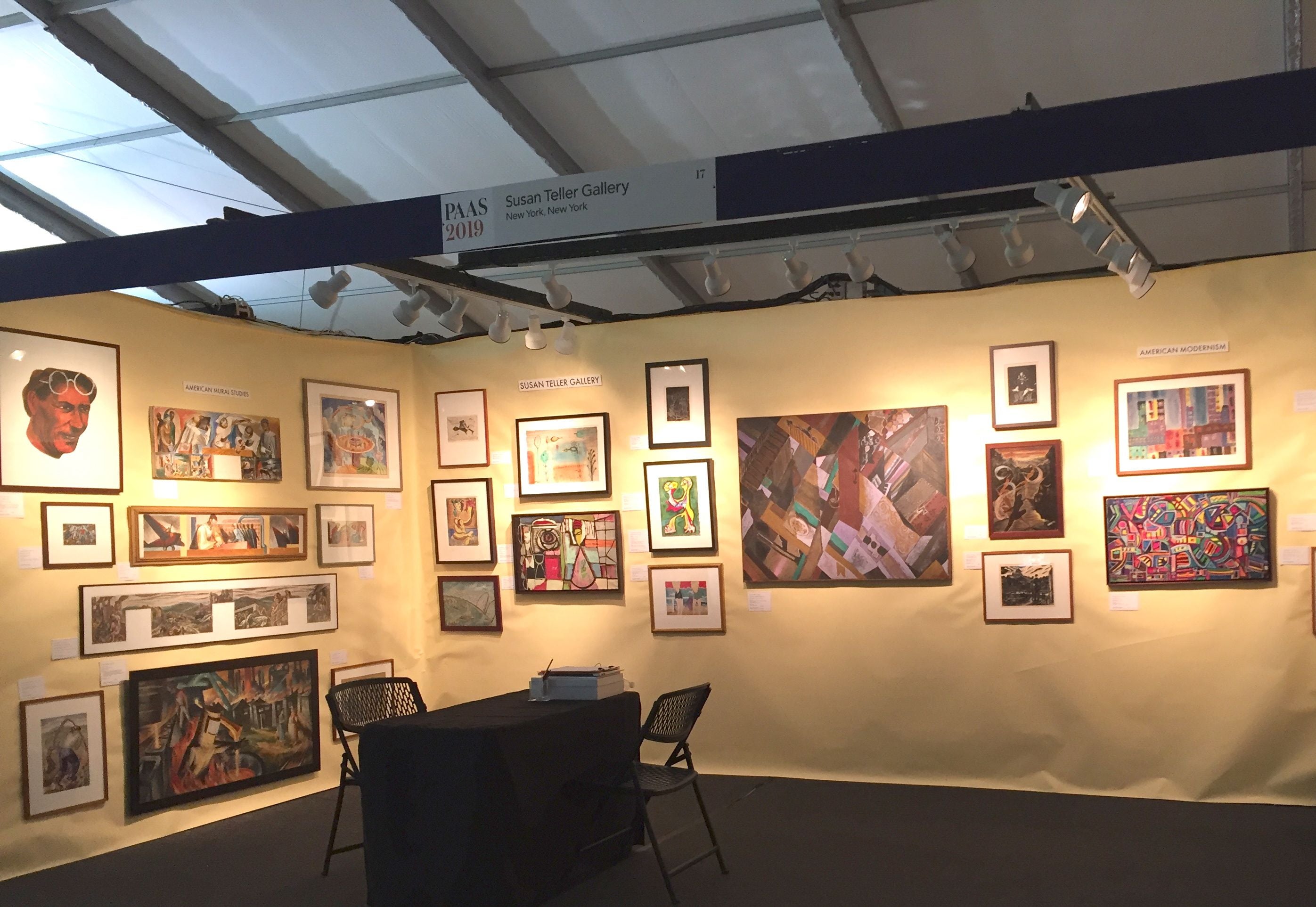
About the Seller
5.0
Gold Seller
These expertly vetted sellers are highly rated and consistently exceed customer expectations.
Established in 1988
1stDibs seller since 2020
88 sales on 1stDibs
Typical response time: 3 hours
- ShippingRetrieving quote...Ships From: New York, NY
- Return PolicyA return for this item may be initiated within 7 days of delivery.
More From This SellerView All
- Alfred Bendiner, Baccaloni in RosenkavalierBy Alfred BendinerLocated in New York, NYThe Italian opera singer, Salvatore Baccaloni (1900-1969) often took comic roles. He worked with several opera companies in Philadelphia between 1951 and 1966. Bendiner was a world t...Category
Mid-20th Century American Modern Figurative Drawings and Watercolors
MaterialsGouache
- Alfred Bendiner, La Alsacienne (pair)By Alfred BendinerLocated in New York, NYLeave it to the Bendiners to find an Alsatian restaurant in Paris (La Taverne Alsacienne) and use it's stationary to such a great end! And thank goodness that the paper required two ...Category
1960s American Modern Figurative Drawings and Watercolors
MaterialsWatercolor
- Alfred Bendiner, (Supper at the Oak Room, Plaza Hotel, NYC)By Alfred BendinerLocated in New York, NYBendiner always took drawing materials with him when he traveled. And a beautiful piece of 'found' paper was never wasted. (Once in Greece on a bus trip he had to acquire paper from ...Category
1960s American Modern Figurative Drawings and Watercolors
MaterialsInk
- Alfred Bendiner, Johnny Hodges (Johnny Hodges, Bass Fiddle & Traps)By Alfred BendinerLocated in New York, NYDid Bendiner ever miss a performance, show, concert, play? Was there anyone he didn't know? This double-side drawing in blue crayon shows Johnny Hodges (jazz saxophonist extraordina...Category
1950s American Modern Figurative Drawings and Watercolors
MaterialsCrayon
- William Sanderson, FascistsBy William SandersonLocated in New York, NYLatvia-born William Sanderson became a contributor to the New Yorker and New Masses magazines during the 1930s. He was drafted into the Army during World Wa...Category
1940s American Modern Figurative Drawings and Watercolors
MaterialsIndia Ink
- Curlee Raven Holton, Three Views of a DancerLocated in New York, NYA painter, draftsman, printmaker and master printer, Curlee Raven Holton (born 1951) taught for twenty years at Lafayette College, Pennsylvania, a...Category
1980s American Modern Figurative Drawings and Watercolors
MaterialsWatercolor
You May Also Like
- Indian Dancer - Vintage Illustration in Ink and WatercolorBy Irene PattinsonLocated in Soquel, CAIndian Dancer - Vintage Illustration in Ink and Watercolor A stoic, dark-haired woman in elaborate dress is sitting cross-legged in this illustration by Irene Pattinson (American, 1909-1999). Pattinson uses fine ink line detail and a vibrant pink watercolor for a splash of color. Signed at the bottom, "Irene Pattinson." Provenance: The Artist, Estate of Irene Pattinson: David Carlson; Estate of Larry Miller Fine Art, Robert Azensky Fine Art. Presented in a new white mat with foam core backing. Mat size: 16"H x 12"W Paper size: 11.75"H x 8.5"W Image size: 7.5"H x 6.5"W Irene Pattinson (American, 1909-1999) studied at the California School of Fine Art (now The San Francisco Art Institute), San Francisco State College and The Marion Hartwell School of Design. She was President of the San Francisco Woman Artists Association 1955-56. Provenance: The Artist, Estate of Irene Pattinson: David Carlson; Estate of Larry Miller Fine Art, Robert Azensky Fine Art. Solo Exhibitions: Lucien Labaudt Gallery 1955; San Francisco Museum of Art, 1961 (39 works). Selected Group Exhibitions: San Francisco Art Association Annual 1948, 54, 55; San Francisco Woman Artists, 1957-1960; Oakland Art Museum Annual, 1951, 58; California Palace of the Legion of Honor, 1960; Richmond Art Center, 1955, 56, 57, 58; San Francisco Art Institute 1959, 60. The Art Bank of the San Francisco Art Association, 1958, 59, 60, 62, 63; Winter Invitational, California Palace of The Legion of Honor, San Francisco, 1960; Fourth Winter Invitational, California Palace of The Legion of Honor, San Francisco, 1963. Awards: First Place, San Francisco Woman Artists Assoc., 1957, 1959; San Francisco Art Festival 1957;Literature: San Francisco Art Institute - A catalog of the Art Ban 1962/63; San Francisco and the Second Wave: The Blair Collection Exhibitions: 1963 The Art Bank of the San Francisco Art Association, San Francisco, CA 1963 California Palace of The Legion of Honor: Forth Winter Invitational, San Francisco, CA 1962 The Art Bank of the San Francisco Art Association, San Francisco, CA 1961 San Francisco Museum of Art, San Francisco, CA 1960 California...Category
1950s American Modern Figurative Drawings and Watercolors
MaterialsIndia Ink, Paper, Watercolor, Pen
- African Mama - Vintage Illustration in Ink and WatercolorBy Irene PattinsonLocated in Soquel, CAAfrican Mama - Vintage Illustration in Ink and Watercolor A charming illustration, by Irene Pattinson (American, 1909-1999), shows a woman with a...Category
1950s American Modern Figurative Drawings and Watercolors
MaterialsPaper, India Ink, Watercolor, Pen
- Portrait Drawing of a Man at a Desk in India Ink on Tan PaperLocated in Soquel, CAPortrait Drawing of a Man at a Desk in India Ink on Tan Paper Figurative drawing of a man at a desk by Jerry O'Day (American, 1912). The man is seated, about to pick up a pen. His features are somewhat exaggerated, showing foreshortening in the arms and legs. This piece is executed with confident strokes but nonetheless feels loose and playful. Signed in the bottom right corner, "Jerry O'Day." Mat size: 20"H x 16"W Paper size: 12"H x 8"W Image window size: 11.25"H x 7.25"W Jerry O'Day is also known as Geraldine Heib. Born in Oakland, California, on June 17, 1912. Geraldine Heib assumed the name Jerry O'Day at an early age. She grew up in Washington and studied in Seattle at the Cornish School of Fine Arts. Upon moving to the San Francisco Bay area in 1938, she further studied with Bufano as a muralist for two years. O'Day wed sculptor David Lemon and had a gallery in a converted cod fishery in Belvedere from 1942 until 1963. At that time, the couple moved to a houseboat in Sausalito, where she remained until her demise on March 30, 1986. Post War California artist, Jerry O'Day studied at the Cornish School of Fine Arts in Seattle; studied with Beniamino Bufano for two years. She lived in the artist's colony at the Cod fishery with artist David Lemon on Belvedere Island in the San Francisco Bay Area from 1942 - 1963. Solo Exhibitions: City of Paris, Rotunda Gallery; Lucien Labaudt Gallery, 1963; Torrance Gallery, San Anselmo, 1955; Marin Art Gallery, Sausalito, 1956; Palace of The Legion of Honor, San Francisco, 1962; East & West Gallery, Fillmore Street, San Francisco; Landmarks Gallery, Marin County, 1991. Selected Group Exhibitions: 65th Annual Painting and Sculpture Exhibition of the San Francisco Art Association at the San Francisco Museum of Art, 1945; Fourth Winter Invitational, California Palace of The Legion of Honor, San Francisco, 1963. Source: David J Carlson...Category
Mid-20th Century American Modern Figurative Drawings and Watercolors
MaterialsIndia Ink, Paper
- Lounge Chair Nap - Vintage Illustration in Ink and WatercolorBy Irene PattinsonLocated in Soquel, CALounge Chair Nap - Vintage Illustration in Ink and Watercolor A man lazes in a lounge chair, book still in hand, as he dozes off with a content e...Category
1950s American Modern Figurative Drawings and Watercolors
MaterialsIndia Ink, Pen, Paper
- Women's World Magazine Cover Illustration , Children SleddingBy Maginel Wright Enright BarneyLocated in Miami, FLChildren Sledding, Women's World Magazine Cover, December 1939 Signed lower center image watercolor, gouache, pencil, and wash on paperCategory
1930s American Modern Figurative Drawings and Watercolors
MaterialsGouache
- Chaim Gross Mid Century Mod Judaica Jewish Watercolor Painting Rabbis WPA ArtistBy Chaim GrossLocated in Surfside, FLChaim Gross (American, 1904-1991) Watercolor painting Rabbinical Talmudic Discussion Hand signed 17 x 29 framed, paper 10 x 22 Chaim Gross (March 17, 1904 – May 5, 1991) was an American modernist sculptor and educator. Gross was born to a Jewish family in Austrian Galicia, in the village of Wolowa (now known as Mezhgorye, Ukraine), in the Carpathian Mountains. In 1911, his family moved to Kolomyia (which was annexed into the Ukrainian USSR in 1939 and became part of newly independent Ukraine in 1991). When World War I ended, Gross and brother Avrom-Leib went to Budapest to join their older siblings Sarah and Pinkas. Gross applied to and was accepted by the art academy in Budapest and studied under the painter Béla Uitz, though within a year a new regime under Miklos Horthy took over and attempted to expel all Jews and foreigners from the country. After being deported from Hungary, Gross began art studies at the Kunstgewerbeschule in Vienna, Austria shortly before immigrating to the United States in 1921. Gross's studies continued in the United States at the Beaux-Arts Institute of Design, where he studied with Elie Nadelman and others, and at the Art Students League of New York, with Robert Laurent. He also attended the Educational Alliance Art School, studying under Abbo Ostrowsky, at the same time as Moses Soyer and Peter Blume. In 1926 Gross began teaching at The Educational Alliance, and continued teaching there for the next 50 years. Louise Nevelson was among his students at the Alliance (in 1934), during the time she was transitioning from painting to sculpture. In the late 1920s and early 1930s he exhibited at the Salons of America exhibitions at the Anderson Galleries and, beginning in 1928, at the Whitney Studio Club. In 1929, Gross experimented with printmaking, and created an important group of 15 linocuts and lithographs of landscapes, New York City streets and parks, women in interiors, the circus, and vaudeville. The entire suite is now in the collection of the Philadelphia Museum of Art. Gross returned to the medium of printmaking in the 1960s, and produced approximately 200 works in the medium over the next two decades. For more than sixty years Chaim Gross's art has expressed optimistic, affirming themes, Judaica, balancing acrobats, cyclists, trapeze artists and mothers and children convey joyfulness, modernism, exuberance, love, and intimacy. This aspect of his work remained consistent with his Jewish Hasidic heritage, which teaches that only in his childlike happiness is man nearest to God. In March 1932 Gross had his first solo exhibition at Gallery 144 in New York City. For a short time they represented Gross, as well as his friends Milton Avery, Moses Soyer, Ahron Ben-Shmuel and others. Gross was primarily a practitioner of the direct carving method, with the majority of his work being carved from wood. Other direct carvers in early 20th-century American art include William Zorach, Jose de Creeft, and Robert Laurent. Works by Chaim Gross can be found in major museums and private collections throughout the United States, with substantial holdings (27 sculptures) at the Hirshhorn Museum and Sculpture Garden. A key work from this era, now at the Smithsonian American Art Museum, is the 1932 birds-eye maple Acrobatic Performers, which is also only one and one quarter inch thick. In 1933 Gross joined the government's PWAP (Public Works of Art Project), which transitioned into the WPA (Works Progress Administration), which Gross worked for later in the 1930s. Under these programs Gross taught and demonstrated art, made sculptures that were placed in schools and public colleges, made work for Federal buildings including the Federal Trade Commission Building, and for the France Overseas and Finnish Buildings at the 1939 New York World's Fair. Gross was also recognized during these years with a silver medal at the Exposition universelle de 1937 in Paris, and in 1942, with a purchase prize at the Metropolitan Museum of Art's "Artists for Victory" exhibition for his wood sculpture of famed circus performer Lillian Leitzel. In 1949 Gross sketched Chaim Weizmann, Israeli President, at several functions in New York City where Weizmann was speaking, Gross completed the bust in bronze later that year. Gross returned to Israel for three months in 1951 (the second of many trips there in the postwar years) to paint a series of 40 watercolors of life in various cities. This series was exhibited at the Jewish Museum (Manhattan) in 1953. He also did some important Hebrew medals. In the 1950s Gross began to make more bronze sculptures alongside his wood and stone pieces, and in 1957 and 1959 he traveled to Rome to work with famed bronze foundries including the Nicci foundry. At the end of the decade Gross was working primarily in bronze which allowed him to create open forms, large-scale works and of course, multiple casts. Gross's large-scale bronze The Family, donated to New York City in 1991 in honor of Mayor Ed Koch, and installed at the Bleecker Street Park at 11th street, is now a fixture of Greenwich Village. In 1959, a survey of Gross's sculpture in wood, stone, and bronze was featured in the exhibit Four American Expressionists curated by Lloyd Goodrich at the Whitney Museum of American Art, with work by Abraham Rattner, Doris Caesar, and Karl Knaths. In 1976, a selection from Gross's important collection of historic African sculpture, formed since the late 1930s, was exhibited at the Worcester Art Museum in the show The Sculptor's Eye: The African Art Collection of Mr. and Mrs. Chaim Gross. Gross was elected into the National Academy of Design as an Associate member, and became a full Academician in 1981. In 1984, he was inducted into the American Academy of Arts and Letters, with Jacob Lawrence and Lukas Foss. In the fall of 1991, Allen Ginsberg gave an important tribute to Gross at the American Academy of Arts and Letters, which is published in their Proceedings. In 1994, Forum Gallery, which now represents the Chaim Gross estate, held a memorial exhibition featuring a sixty-year survey of Gross's work.In March 1932 Gross had his first solo exhibition at Gallery 144 in New York City. For a short time they represented Gross, as well as his friends Milton Avery, Moses Soyer, Ahron Ben-Shmuel and others. Gross was primarily a practitioner of the direct carving method, with the majority of his work being carved from wood. Other direct carvers in early 20th-century American art include William Zorach, Jose de Creeft, and Robert Laurent. Works by Chaim Gross can be found in major museums and private collections throughout the United States, with substantial holdings (27 sculptures) at the Hirshhorn Museum and Sculpture Garden. A key work from this era, now at the Smithsonian American Art Museum, is the 1932 birds-eye maple Acrobatic Performers, which is also only one and one quarter inch thick. In 1933 Gross joined the government's PWAP (Public Works of Art Project), which transitioned into the WPA (Works Progress Administration), which Gross worked for later in the 1930s. Under these programs Gross taught and demonstrated art, made sculptures that were placed in schools and public colleges, made work for Federal buildings including the Federal Trade Commission Building, and for the France Overseas and Finnish Buildings at the 1939 New York World's Fair. Gross was also recognized during these years with a silver medal at the Exposition universelle de 1937 in Paris, and in 1942, with a purchase prize at the Metropolitan Museum of Art's "Artists for Victory" exhibition for his wood sculpture of famed circus performer Lillian Leitzel. In 1949 Gross sketched Chaim Weizmann, President of Israel, at several functions in New York City where Weizmann was speaking, Gross completed the bust in bronze later that year. Gross returned to Israel for three months in 1951 (the second of many trips there in the postwar years) to paint a series of 40 watercolors of life in various cities. This series was exhibited at the Jewish Museum (Manhattan) in 1953. In the 1950s Gross began to make more bronze sculptures alongside his wood and stone pieces, and in 1957 and 1959 he traveled to Rome to work with famed bronze foundries including the Nicci foundry. At the end of the decade Gross was working primarily in bronze which allowed him to create open forms, large-scale works and of course, multiple casts. Gross's large-scale bronze The Family, donated to New York City in 1991 in honor of Mayor Ed Koch, and installed at the Bleecker Street Park at 11th street, is now a fixture of Greenwich Village. In 1959, a survey of Gross's sculpture in wood, stone, and bronze was featured in the exhibit Four American Expressionists curated by Lloyd Goodrich at the Whitney Museum of American Art, with work by Abraham Rattner, Doris Caesar, and Karl Knaths. In 1976, a selection from Gross's important collection of historic African sculpture, formed since the late 1930s, was exhibited at the Worcester Art Museum in the show The Sculptor's Eye: The African Art Collection of Mr. and Mrs. Chaim Gross. Gross was elected into the National Academy of Design as an Associate member, and became a full Academician in 1981. In 1984, he was inducted into the American Academy of Arts and Letters, with Jacob Lawrence and Lukas Foss. In the fall of 1991, Allen Ginsberg gave an important tribute to Gross at the American Academy of Arts and Letters, which is published in their Proceedings. In 1994, Forum Gallery, which now represents the Chaim Gross estate, held a memorial exhibition featuring a sixty-year survey of Gross's work. Gross was a professor of printmaking and sculpture at both the Educational Alliance and the New School for Social Research in New York City, as well as at the Brooklyn Museum Art School, the MoMA art school, the Art Student's League and the New Art School (which Gross ran briefly with Alexander Dobkin...Category
Mid-20th Century American Modern Figurative Drawings and Watercolors
MaterialsPaper, Watercolor
Recently Viewed
View AllMore Ways To Browse
Jan Szczepkowski On Sale
Jean-Charles Lauthe On Sale
Jorge Barradas
Juan Nakai
Malaga Cove
Marjorie Tallchief
Peyton Pitts On Sale
Tibor Gertler On Sale
Claudio Bravo Pencil
Guinevere Antiques
Appalachian Trail Map
Arthur Getz
Bror Julius Olsson Nordfeldt On Sale
Buford Crossland
C. Harry Allis On Sale
Craig Rubadoux
John Galliano 2021
Kurt Herrmann On Sale
